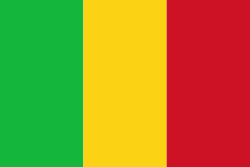Kayes
Kayes (Bambara: ߞߊߦߌ tr. Kayi, Soninké: Xaayi) is a city in western Mali on the Sénégal River with a population of 127,368 at the 2009 census. Kayes is the capital of the administrative region of the same name. The name "Kayes" comes from the Soninké word "karré", which describes a low humid place that floods in rainy season. The city is located 420 km northwest of the capital Bamako.
Prior to French colonial expansion, Kayes was a small village. Its location on the path of the future Dakar-Niger Railway, and the French need for trade centers, led to the creation of the Kayes market town in 1881. It remains a transport hub, primarily for Senegalese trade, to this day. In 1892, Kayes became the capital of the French Sudan; Bamako replaced it as the capital, first of the state of Haut Sénégal-Niger on October 17, 1899, then as the capital of all of French Sudan in 1908.
Prior to French colonial expansion, Kayes was a small village. Its location on the path of the future Dakar-Niger Railway, and the French need for trade centers, led to the creation of the Kayes market town in 1881. It remains a transport hub, primarily for Senegalese trade, to this day. In 1892, Kayes became the capital of the French Sudan; Bamako replaced it as the capital, first of the state of Haut Sénégal-Niger on October 17, 1899, then as the capital of all of French Sudan in 1908.
Map - Kayes
Map
Country - Mali
 |
|
| Flag of Mali | |
Present-day Mali was once part of three extremely powerful and wealthy West African empires that controlled trans-Saharan trade: the Ghana Empire (for which Ghana is named), the Mali Empire (for which Mali is named), and the Songhai Empire. At its peak in 1300, the Mali Empire was the wealthiest country in Africa, covering an area about twice the size of modern-day France and stretched to the west coast of the continent. Mali was also one of the wealthiest countries on earth, and its emperor at its zenith, Mansa Musa, is believed to be possibly the wealthiest individual in history. Besides being an economic powerhouse, medieval Mali was a centre of Islam, culture and knowledge, with Timbuktu becoming a renowned place of learning with its university, one of the oldest in the world still active. The expanding Songhai Empire absorbed the empire in 1468, followed by a Saadian army which defeated the Songhai in 1591. In the late 19th century, during the Scramble for Africa, France seized control of Mali, making it a part of French Sudan. French Sudan (then known as the Sudanese Republic) joined with Senegal in 1959, achieving independence in 1960 as the Mali Federation. Shortly thereafter, following Senegal's withdrawal from the federation, the Sudanese Republic declared itself the independent Republic of Mali. After a long period of one-party rule, a coup in 1991 led to the writing of a new constitution and the establishment of Mali as a democratic, multi-party state.
Currency / Language
| ISO | Currency | Symbol | Significant figures |
|---|---|---|---|
| XOF | West African CFA franc | Fr | 0 |
| ISO | Language |
|---|---|
| BM | Bambara language |
| FR | French language |















